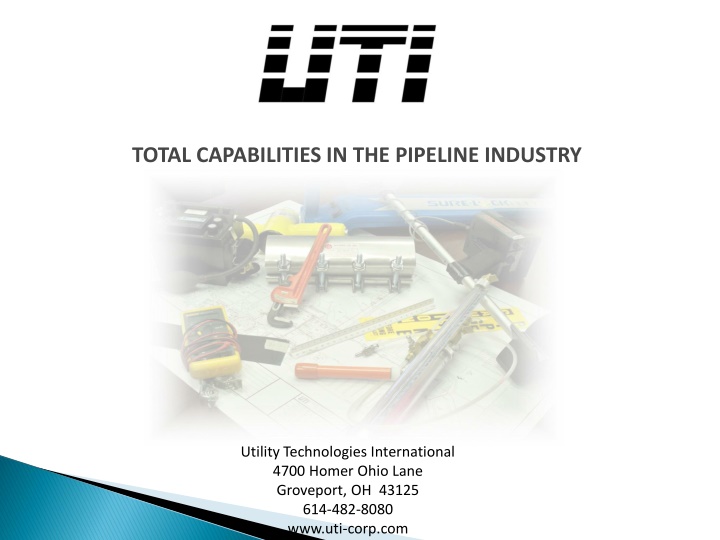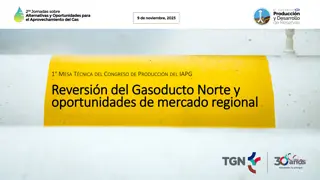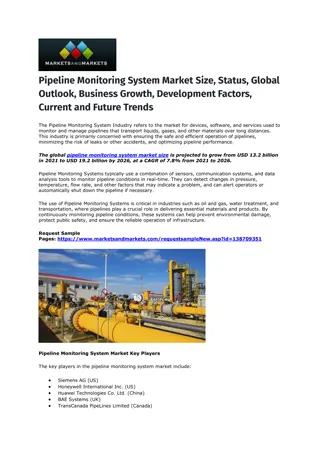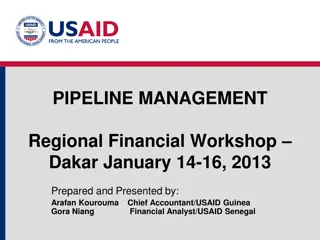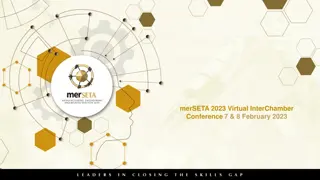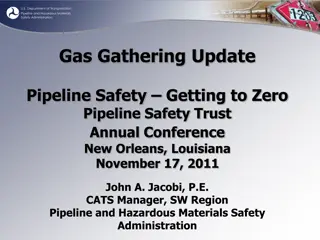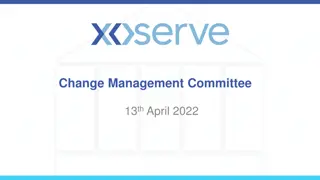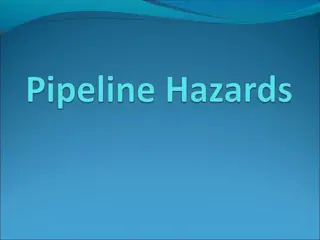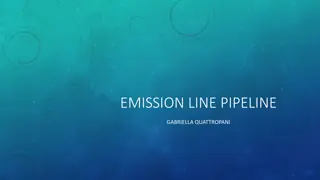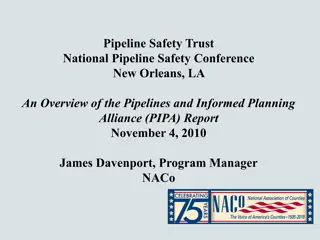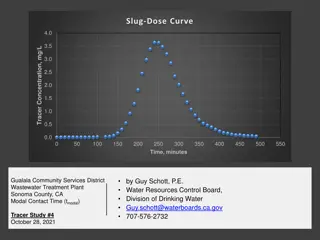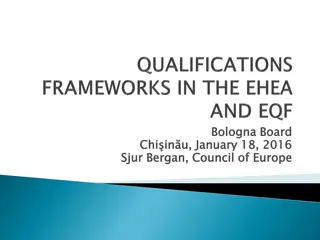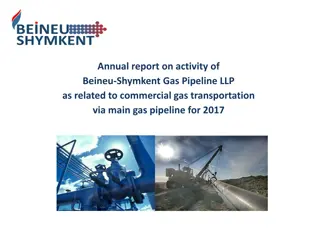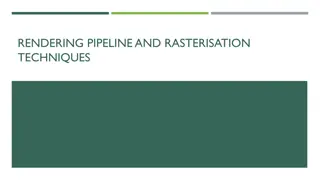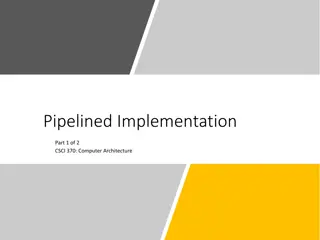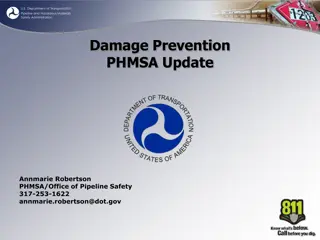Total Capabilities in Pipeline Industry Qualifications
Gas Transmission Integrity Management (GT IM) according to 49 CFR Part 192 is crucial for operators to maintain the integrity of gas transmission pipelines in High Consequence Areas (HCAs). Establishing and implementing an integrity management program involves baseline assessment, selecting appropriate assessment methods, and conducting reassessments. The process includes data gathering, feasibility assessments, indirect inspections, tool selection, conducting tests and surveys, direct examinations through excavations, data analysis, calculations, and recommendations. Specialized services like ILI/Pigging, Direct Assessment, and Pressure Testing offer effective ways to ensure pipeline integrity without service interruptions.
Uploaded on Mar 16, 2025 | 0 Views
Download Presentation

Please find below an Image/Link to download the presentation.
The content on the website is provided AS IS for your information and personal use only. It may not be sold, licensed, or shared on other websites without obtaining consent from the author.If you encounter any issues during the download, it is possible that the publisher has removed the file from their server.
You are allowed to download the files provided on this website for personal or commercial use, subject to the condition that they are used lawfully. All files are the property of their respective owners.
The content on the website is provided AS IS for your information and personal use only. It may not be sold, licensed, or shared on other websites without obtaining consent from the author.
E N D
Presentation Transcript
TOTAL CAPABILITIES IN THE PIPELINE INDUSTRY Utility Technologies International 4700 Homer Ohio Lane Groveport, OH 43125 614-482-8080 www.uti-corp.com
Qualifications, Identifying Threats, Preventative & Mitigative Measures and Program Effectiveness
Gas Transmission Integrity Management (GT IM) 49 CFR Part 192, Subpart O-specifies how pipeline operators must identify, prioritize, assess, evaluate, repair and validate the integrity of gas transmission pipelines that could, in the event of a leak or failure, affect High Consequence Areas (HCAs). Operators were given until December 17, 2004 to write and implement their IM programs.
Once your program was established, the next step was to implement what your program dictates to assess the integrity of your pipeline. Baseline Assessment Appropriate Assessment Method Reassessment Intervals Confirmatory Full reassessment
Assessment Method Selection Use pipeline data, pipeline construction and operational information to determine the best fit assessment method Document the reasons for the method selection Document your assessment process
All assessment methods are 4 step processes Pre-Assessment Data Gathering Feasibility Indirect Inspection Selection of tools Setting parameters for test/survey Conducting test/survey Identification of indications Direct Examination Excavations to investigate indications from predicted areas of concern or discovered indications Measurements taken, observations made and all data documented Remediation performed Post Assessment Analysis of data Calculations Recommendations
ILI/ Pigging Specialized service that requires a 3rd party contractor May not require pipe to be out of service Limits due to pipe construction (piggable vs. non-piggable) Direct Assessment Uses above ground tools, operator knowledge of the pipeline and experience to predict trouble spots Does not require the pipe to be taken out of service Number of excavations may vary based on the extent of corrosion Pressure Testing Uses water or inert gas Test pressure based on MAOP and SMYS of pipe Elevation of pipe must be considered Requires pipe to be removed from service
UTI follows a conservative approach to its Integrity Management thought process. Use guidance to dictate the flow of the process PHMSA/Part 192 NACE Guidance ASME Guidance Determine the best methodology for each pipeline system Ensure the data supports the choice/methodology for assessment Document the process Pre Assessment (data gathering) Indirect Inspection (tool selection) Direct Examination (what was observed/found, measurements, etc.) Post Assessment (recommendations, remaining life/strength, etc.)
Initial Audits Interpretation of the regulatory requirements and their application Assessments o Information used to determine best assessment method for pipeline Intervals o Proper reassessment intervals met and timeline for next reassessment based on type of assessment selected o Confirmatory o Full reassessment Data Interpretation o From electrical survey to dig site selection to discovered condition of pipe based on survey Remediation
Audit Trends More recently, the audits have focused on: o The Integrity Program process o Procedures o Documentation o Data analysis
Qualifications Identifying Threats Preventative and Mitigative Measures Program Evaluation
This rule, in part, established requirements for supervisory and other personnel with IM program functions. PHMSA has recognized inconsistencies in how the requirements have been implemented by operators and is issuing this Advisory Bulletin to remind operators of their responsibility to include qualification requirements for IM personnel, as required by PHMSA regulations and discussed in the American Society of Mechanical Engineers (ASME) ASME B31.8S 2004. DATES: April 10, 2017
It requires operator personnel involved in the IM program to be qualified for their assigned responsibilities, including the following: Personnel qualification requirements must be identified for anyone involved in the IM program. This applies to both operator and contractor personnel (contractors, suppliers, vendors, etc.) Qualification criteria must include minimum requirements for experience or training in order to verify individuals have the knowledge and skills necessary to perform IM-related tasks The operator must determine whether qualifications are current. The rule requires operators to verify that the personnel who execute activities within the IM program are qualified in accordance with the quality assurance process required by 192.911(l). Documentation of qualification must be maintained in accordance with the operator s IM program.
IM Personnel Supervisory Personnel Persons who carry out assessments and evaluate assessment results Persons responsible for preventative and mitigative measures
Supervisory Personnel Section 192.915(a) Supervisory Personnel The regulation covers qualification and training requirements for supervisory personnel with responsibilities in an IM program. This rule requires operators to verify that the IM program requires supervisory personnel to have the appropriate training or experience for their assigned responsibilities, including the following: Personnel with supervisory authority that relates to the operator s IM process must meet documented qualification requirements for the aspects of the IM program that fall under their authority
Supervisory Personnel Tracking of qualification deficiencies and requalification requirements is essential to verify that individuals in supervisory positions are qualified. Qualification requirements must include minimum requirements for experience or training to verify individuals have the knowledge to perform IM-related tasks
Persons who Carry out Assessments and Evaluate Assessment Results Section 192.915(b) Covers qualification requirements for personnel performing certain IM tasks related to the conduct of integrity assessments, analysis of integrity assessment results, and the decisions on actions to be taken based on integrity assessments. Requires operators to verify the IM program requires qualification of personnel who carry out assessments and evaluate assessment results, including the following: o Personnel who carry out or evaluate assessment information must meet documented qualification requirements this applies to both operator and contractor personnel.
Persons who Carry out Assessments and Evaluate Assessment Results o Qualification requirements must include minimum requirements for experience or training to verify that individuals have the knowledge and skills necessary to perform IM-related tasks, including analysis, data integration, integrity assessments, and assessment results evaluation. o Qualification requirements must be established for all tasks necessary to carry out integrity assessments and evaluate assessment results, including: Performing the integrity assessment; Evaluating the results of the integrity assessment; Integrating any other available information or data gathered in accordance with 192.917(b) that is applicable to the covered segment being assessed; Deciding on actions to be taken based on these assessments. o The operator is responsible for verifying the qualifications of contractor personnel who conduct essential tasks in performing or evaluating assessments.
Persons Responsible for Preventive and Mitigative Measures Section 192.915(c) The regulation covers qualification requirements for personnel who implement preventive and mitigative measures and who supervise excavation work carried out in conjunction with an integrity assessment.
Persons Responsible for Preventive and Mitigative Measures This rule mandates that operators verify their IM program requires qualification of personnel who participate in implementing preventive measures and mitigative measures, including: Personnel who mark and locate buried structures, Personnel who directly supervise integrity assessment excavation work, and Other personnel who participate in implementing preventive measures and mitigative measures. Applying risk assessment results to determine what additional preventive measures and mitigative measures need to be implemented for the covered segment being assessed in accordance with 192.917(c).
Persons Responsible for Preventive and Mitigative Measures Personnel who implement preventive and mitigative measures may hold a range of job positions, including (but not limited to): Management and technical personnel, risk evaluators, operators, excavation crews, welders, and pipeline safety engineers. With respect to these personnel, the rule requires that operators: o Define the roles and responsibilities of personnel implementing preventive and mitigative measures o Define the qualification requirements as they relate to implementing preventive and mitigative measures
UTI has established an Integrity Management Committee Engineering Chris Lanka (VP Engineering) Brad Leonard (Integrity Services Manager) o NACE CP III Operations Management Jason Julian (VP of Operations) John Johnson (Director of Operations) Jeff Maynard (Project Manager) Nicole Washington (Compliance Manager) o NACE Direct Assessment ILI Pipeline Integrity Management Field Personnel OQ
Committee meeting discussions include: Processes and procedures that may need to be improved Determination if additional documentation is needed Review of new requirements that may impact the success of the program. Recommendations from audits that may be pertinent to other pipelines and/or clients Conversations with other operators Lessons learned from previous assessments Identifying Threats Preventive and Mitigative Measures Program Improvement/Evaluation
Identifying threats to pipeline integrity and use the threat identification in the integrity program. Annual review must precede planning of any IM work Review threat identification documentation Data Gathering and Integration Review the risk assessments to verify prioritization Plastic transmission pipeline HCA Regions o Verify PIR calculation o Check the mapping and limits of HCA based on PIR o Field inspect to determine if areas still meet criteria to be an HCA (add/remove) All of this information will be used to determine the appropriate assessment method for the integrity of your pipeline
Review your High Consequence Areas and the Identified sites to make sure the information is still relevant Google Maps/Google Earth Field Visit Review this info during Leak Surveys and document any changes Make sure there is a procedure/process in place for accurate determination of what is an HCA, what constitutes a change , and follow up. Document
192.935 (c) Automatic Shut-off Valves (ASV)/Remote Control Valves (RCV) Federal pipeline safety regulations require operators to install in-line sectionalizing valves ( block valves ) on natural gas transmission pipelines at prescribed intervals in order to completely shut off the flow of gas for both routine maintenance activities and emergency response. One of the existing provisions of the Transmission Integrity Management Program (TIMP) rule is for operators to evaluate if the use of ASVs or RCVs would be an efficient means to add protection to High Consequence Areas (HCAs) in the event of a natural gas release.
ASV Benefits Will automatically close when the pressure sensors near the valve detect a pressure drop that meets predetermined operating criteria Normally closes more rapidly than a manually operated valve that requires operating personnel to travel to the valve location Response Time ASV Challenges and Issues Possibility of an unintended valve closure and related consequences. False closure of a transmission block valve under peak load conditions may subject the operator to widespread customer outages, customer product losses and safety impacts Possible for an ASV to malfunction and partially or completely close Cost
RCV Benefits RCV Challenges and Issues Allows a control room operator to execute a signal to close a line valve when an incident occurs Does not ensure immediate valve closure during an incident Requires personnel to evaluate system conditions Anomaly? Routine event Allows a line valve to be operated sooner than a manually operated valve Potential time savings Any equipment failure could have severe adverse consequences to the public Provides added protection to an HCA or in certain remote locations Cost
System risk analysis for ASV/RCV Conduct a risk assessment that provides a thorough investigation into the need of added protection using ASV or RCV s Things to consider and include in risk assessment: Swiftness of leak detection Pipe shutdown capabilities Type of gas being transported Operating pressure Rate of potential release Pipeline profile Potential for ignition Location of nearest response personnel All of these must be documented
Areas of consideration for the evaluation and evolution of your Integrity Management Program Internal Audits Continuous Improvement Data Evaluation, Tracking/Trends Number of miles of pipeline inspected Number of immediate repairs completed Number of Scheduled repairs Number of leaks, failures and inspections
Records (192.947) Management of Change Thorough documentation using proper form to notify the appropriate entities of significant changes to the program or plan Appropriate communication of the change to those impacted and other stakeholders Annual Records Review Compliance deadlines Review recommendations to ensure that all suggested time lines for follow-up are completed prior to expiration of the timeframe. Procedures Review procedures to ensure this documentation is in alignment with current equipment, qualification criteria, tools and technology. Review to ensure all assessment techniques that require procedures have them.
Initial Audits focused on Interpretation of the regulatory requirements and their application Assessments o Information used to determine best assessment method for pipeline Intervals o Proper reassessment intervals met and timeline for next reassessment based on type of assessment selected o Confirmatory o Full reassessment Data Interpretation o From electrical survey to dig site selection to discovered condition of pipe based on survey Remediation
Audit Trends More recently, the audits have focused on: oThe Integrity Program process oProcedures oDocumentation oData analysis
UTI has established an Integrity Management Committee Engineering Chris Lanka (VP Engineering) Brad Leonard (Integrity Services Manager) o NACE CP III Operations Management Jason Julian (VP of Operations) John Johnson (Director of Operations) Jeff Maynard (Project Manager) Nicole Washington (Compliance Manager) o NACE Direct Assessment ILI Pipeline Integrity Management Field Personnel OQ
Identify Threats Review your High Consequence Areas and the Identified Sites to make sure the information is still relevant Google Maps/Google Earth Field visit Review this information during leak surveys and document any changes Make sure there is a procedure/process in place for accurate determination of what is an HCA, what constitutes a change , and follow up. Document
Preventative and Mitigative Measures System risk analysis for ASV/RCV Conduct a risk assessment that provides a thorough investigation into the need of added protection using ASV or RCV s Things to consider and include in risk assessment: Swiftness of leak detection Pipe shutdown capabilities Type of gas being transported Operating pressure Rate of potential release Pipeline profile Potential for ignition Location of nearest response personnel All of these must be documented
Integrity Management Program Evaluation Records (192.947) Management of Change o Thorough documentation using proper form to notify the appropriate entities of significant changes to the program or plan o Appropriate communication of the change to those impacted and other stakeholders Annual Records Review o Compliance deadlines o Review recommendations to ensure that all suggested time lines for follow up are completed prior to expiration of the timeframe. Procedures o Review procedures to ensure this documentation is in alignment with current equipment, qualification criteria, tools and technology. o Review to ensure all assessment techniques that require procedures have them.
Utility Technologies International 4700 Homer Ohio Lane Groveport, OH 43125 614-482-8080 www.uti-corp.com Jeff Maynard Project Manager jmaynard@uti-corp.com Nicole Washington Compliance Manager nwashington@uti-corp.com
